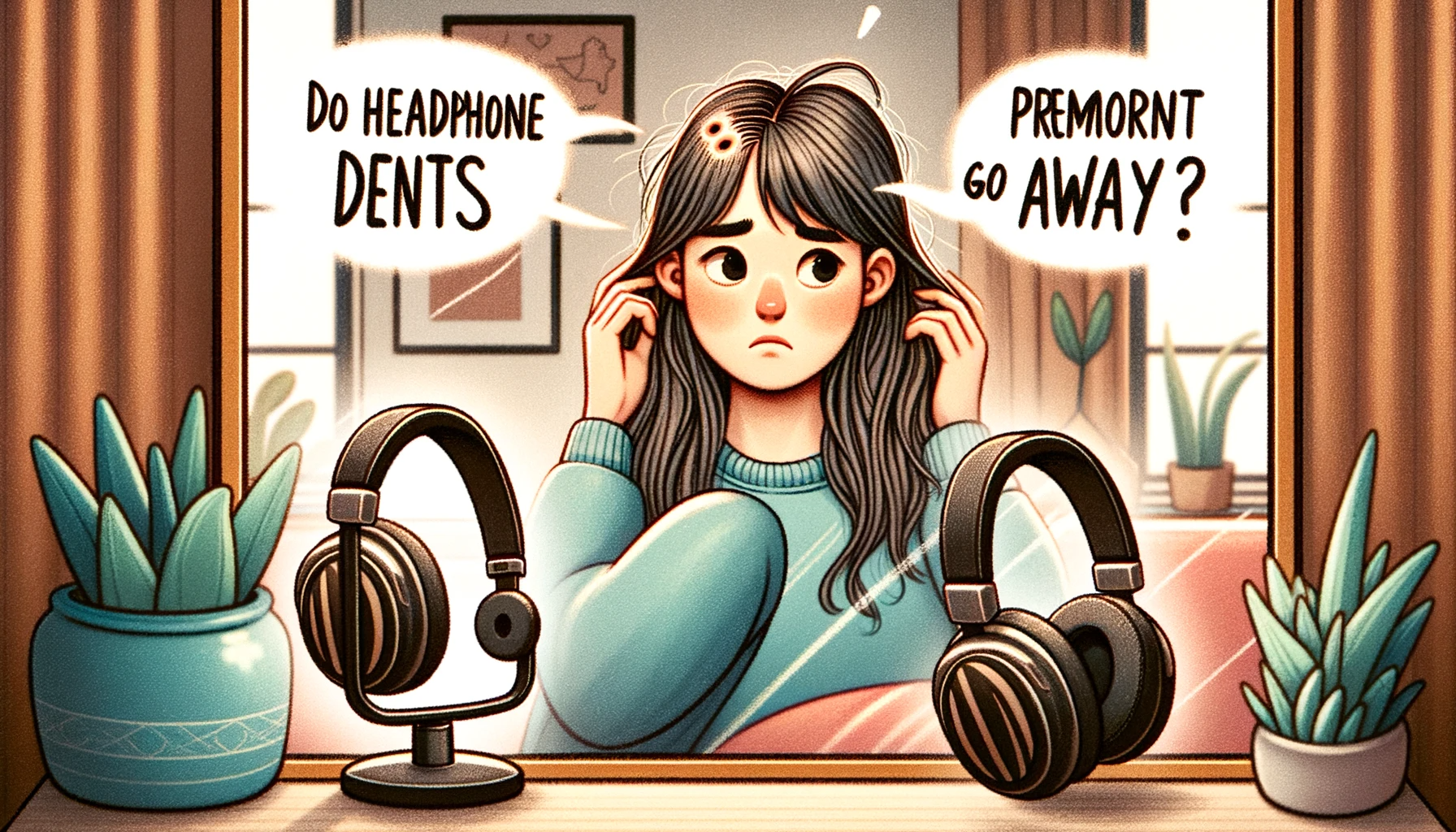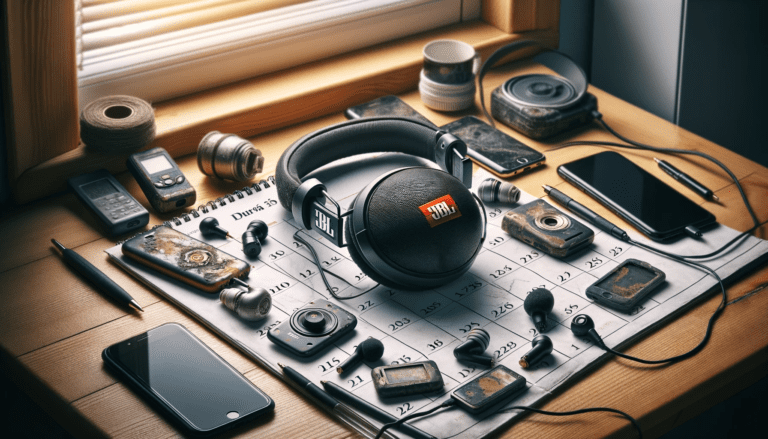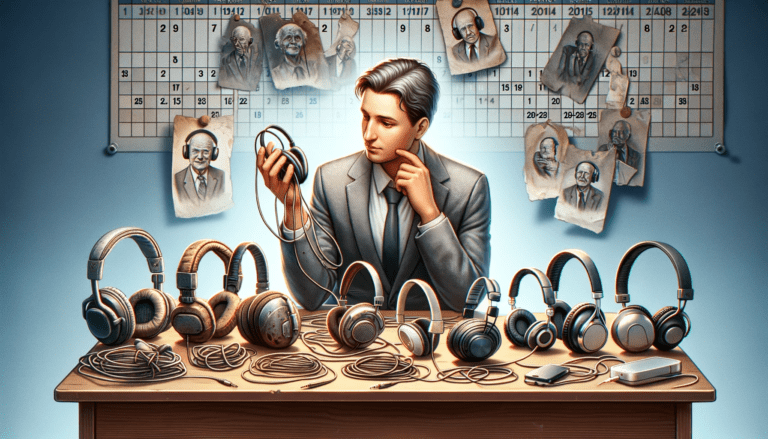Have you ever experienced the frustration of finding unsightly dents on your beloved headphones? It’s a common annoyance that can make even the most music-loving individual cringe. We invest our hard-earned money in high-quality headphones, hoping for an immersive auditory experience, only to have our dreams shattered by these irksome imperfections.
But fear not! In this article, we will delve into the world of headphone dents and explore whether there is a glimmer of hope for them to magically disappear.
The annoyance of headphone dents
Headphone dents can truly be a thorn in one’s side. They not only compromise the aesthetics but can also affect the functionality and comfort of your headphones.
Picture this: you’re sitting back, ready to indulge in your favorite playlist when you notice an unsightly dent staring back at you. Suddenly, all hopes of auditory bliss are dashed as the focus shifts to the blemish on your once pristine headphones.
These seemingly innocent dents may result from a variety of mishaps. Perhaps you accidentally dropped them or sat on them unintentionally (we’ve all been there).
Sometimes, even storing them improperly or placing heavy objects on top could leave behind these pesky marks. Regardless of how they occurred, they can become an unwelcome reminder every time you put your headphones on.
Exploring the possibility of headphone dents disappearing
Now comes the million-dollar question: Can these annoying headphone dents disappear as mysteriously as they appeared? Well, it depends.
The outcome varies based on several factors such as dent severity and headphone material. In some cases, minor dents may naturally fade away over time with regular use and handling.
The cushioning materials inside some headphones have been known to regain their shape after repetitive use. However, this is not always the case, and more often than not, those stubborn dents might prove to be a long-lasting eyesore.
But fear not! All hope is not lost.
There are temporary fixes available that can help alleviate the frustration caused by headphone dents. From using gentle heat to applying suction, various techniques have been known to provide at least partial relief from these undesirable blemishes.
For more severe or persistent dents, seeking professional repair options might be necessary. So don’t lose heart just yet!
Understanding Headphone Dents
Causes of Headphone Dents (e.g., pressure, mishandling)
When it comes to those frustrating headphone dents, there are a few culprits that we can point our fingers at. One common cause is the excessive pressure exerted on the headphones. This can happen when we accidentally sit on them or unknowingly place heavy objects over them in our bags.
The delicate structure of headphones can only withstand so much squeezing before it succumbs to unsightly dents. Mishandling also plays a significant role in the formation of headphone dents.
We’ve all been guilty of carelessly tossing our headphones into bags or stuffing them into pockets without giving a second thought to their vulnerability. Rough handling can lead to bends and deformations that result in unwanted dents.
Different Types of Headphone Materials and Their Susceptibility to Dents
Headphones come in various shapes and sizes, but they also employ different materials for their construction. Each material has its own level of susceptibility when it comes to denting.
Metallic headphones, such as those with aluminum or stainless steel frames, tend to be more prone to dents due to their rigid nature. The sturdy build may provide excellent durability overall but leaves them vulnerable to visible indentations caused by external pressure.
On the other hand, plastic-based headphones usually have more flexibility, making them less susceptible to major dents. However, this doesn’t mean that plastic headphones are entirely immune from denting.
Cheaper plastic materials can still experience deformation under substantial force or prolonged pressure. It’s essential to strike a balance between comfort and durability when choosing your ideal pair.
Some premium headphone models incorporate unique materials like carbon fiber or reinforced polymers that offer superior resistance against denting while maintaining lightness and comfort. Investing in these high-quality materials might be a worthwhile consideration for those seeking a dent-free listening experience.
To sum it up, dents in headphones can be caused by excessive pressure and mishandling. When it comes to materials, metal-based headphones are generally more prone to denting, while plastic-based ones offer slightly better resistance.
However, higher-end headphones often utilize innovative materials that strike an optimal balance between durability and flexibility. Understanding these factors will help you make informed decisions when it comes to choosing your next pair of headphones.
Can headphone dents be fixed?
Temporary fixes for minor dents (e.g., using heat, suction)
When it comes to those pesky headphone dents, fear not, for there are temporary fixes that can work wonders on minor imperfections. One such remedy involves the clever use of heat to reshape the material and restore its original form.
To attempt this method, you’ll need a hairdryer or a heat gun set to a low temperature. Gently warm up the affected area by directing the hot air towards it while maintaining a safe distance.
Then, using your fingers or a soft cloth, apply gentle pressure and mold the heated material back into place. Remember to be patient and cautious during this process as excessive heat or force can potentially damage your beloved headphones further.
Another temporary fix that often yields promising results is employing the power of suction. This technique is particularly effective on headphones with plastic or rubberized surfaces.
Start by moistening a small suction cup (you can find these in hardware stores) or even create one using adhesive tape and a small piece of plastic. Firmly press the suction cup onto the dent and then carefully pull it away in an upward motion, creating a vacuum effect that may help pop out the dent.
Professional repair options for severe or persistent dents
If you’ve tried all the DIY tricks in your arsenal but still find yourself faced with stubborn headphone dents, it may be time to seek professional assistance. Many reputable electronics repair shops offer specialized services for fixing headphone deformities.
These professionals have access to specialized tools and techniques that can tackle more complex cases. One common approach used by professionals is employing precision heating methods coupled with delicate molding processes.
By applying controlled heat directly onto the affected area while simultaneously reshaping it with expert hands, these skilled technicians can often restore headphones to their former glory. In severe cases where the dents have caused internal damage or compromised the audio quality, professional repair may involve replacing damaged components or even entire sections of the headphones.
This process requires expertise and access to genuine replacement parts to ensure optimal performance. Although it may be a more expensive option, trusting your headphones in the hands of professionals can ultimately save you from further frustration and potentially extend their lifespan.
Remember, while attempting temporary fixes can be fun and sometimes successful, professional repair options are best suited for severe or persistent headphone dents. If you’re unsure about your DIY skills or if the damage is beyond your comfort zone, it’s always wise to consult with experts who possess the necessary knowledge and experience to address your specific headphone issues.
Prevention is Better than Cure
Proper Storage and Handling Techniques to Avoid Headphone Dents
When it comes to preserving the pristine condition of your beloved headphones, prevention truly is key. By adopting proper storage and handling techniques, you can significantly reduce the risk of those unsightly dents appearing on your prized audio companions. To begin with, always make sure to store your headphones in a safe and secure place when not in use.
Avoid tossing them haphazardly onto surfaces or stuffing them into overcrowded bags. Instead, consider investing in a dedicated carrying case that provides ample protection against external pressure or accidental impacts.
Furthermore, handle your headphones with care whenever you put them on or take them off. Gently adjust the size of the headband to fit comfortably without applying excessive force.
If your headphones have foldable components, be mindful not to exert too much pressure when extending or retracting them. Remember, a little extra caution can go a long way in preserving their original shape.
Protective Accessories that Can Prevent Denting (e.g., Carrying Cases)
In addition to careful storage and handling practices, utilizing protective accessories can offer an extra layer of defense against unwanted headphone dents. One such essential accessory is a high-quality carrying case specifically designed for your headphones’ make and model. A well-designed carrying case acts as a shield against potential damage caused by external factors such as accidental drops or crushing forces during transportation.
Look for cases made from durable materials like hard-shell plastics or padded fabrics that provide cushioning protection while also safeguarding against scratches and dust accumulation. Moreover, some carrying cases feature compartments with custom-fit inserts that prevent the headphones from moving around inside the case.
This additional stability further minimizes the chances of any jostling or impact that may result in dents. Remember that prevention doesn’t stop at just carrying cases.
Other accessories, such as cable organizers or headphone stands, can also help in maintaining the shape and condition of your headphones. By keeping cables neatly coiled and headphones properly stored when not in use, you can reduce the risk of accidents that may cause dents or unnecessary wear and tear.
So, don’t overlook the importance of prevention – invest in protective accessories and adopt proper storage and handling techniques to prolong the life and pristine appearance of your headphones. (Note: Remember to continue with the other sections of your article.)
Exploring Alternative Solutions
Customizable headphones that allow for interchangeable parts to replace damaged ones
One alternative solution to dealing with headphone dents is investing in customizable headphones. These innovative designs offer interchangeable parts, meaning you can easily replace any damaged components.
With this feature, you no longer have to worry about an unsightly dent ruining the overall aesthetic of your headphones. Simply swap out the affected part for a brand new one, and voila!
Your headphones are as good as new. Moreover, customizable headphones often come with a wide range of options, allowing you to personalize your listening experience.
From different headband styles to various ear cup materials, these headphones cater to individual preferences like never before. So not only do they provide a solution for dent repair, but they also offer enhanced comfort and customization options that can greatly improve your overall enjoyment.
3D printing technology as a potential solution for repairing or replacing damaged parts
Another exciting alternative solution on the horizon is 3D printing technology. This cutting-edge innovation has the potential to revolutionize how we repair or replace damaged headphone parts.
By utilizing specialized software and high-quality materials, 3D printers can produce precise replicas of original components with remarkable accuracy. Imagine being able to simply download a blueprint for the specific part you need and then print it right at home.
No need for costly repairs or searching for obscure replacement parts—the power would be in your hands! While 3D printing is still emerging in the consumer market, its potential in addressing headphone dents holds great promise.
Lesser-Known Facts About Headphone Denting
The impact of temperature changes on the likelihood of dent formation
Believe it or not, temperature fluctuations can have an impact on headphone dent formation. When exposed to extreme heat or cold conditions, some materials used in headphones may expand or contract, making them more susceptible to dents.
Therefore, it’s essential to be mindful of the environment in which you store and use your headphones. To minimize the risk, avoid leaving your headphones in extreme temperatures for prolonged periods.
Instead, keep them stored in a cool, dry place when not in use. This simple precaution can help preserve their structural integrity and reduce the chances of dents forming.
How different head shapes can affect the occurrence and severity of headphone dents?
Believe it or not, the shape of your head can have an impact on how headphone dents develop. People with larger heads or prominent features might experience more pressure points against their headphones, potentially leading to increased denting over time. However, this doesn’t mean that those with smaller heads are immune to dents; improper fit or excessive clamping force can still cause damage.
To mitigate this issue regardless of head shape or size, it’s crucial to find headphones that offer adjustable sizing options and cushioning materials that distribute pressure evenly. By ensuring a comfortable fit that doesn’t exert excessive force on specific areas of your head, you can reduce the risk of unsightly dents.
Conclusion
While headphone dents may seem like a frustrating problem at first glance, there are alternative solutions available. Customizable headphones with interchangeable parts allow for easy replacement of damaged components without compromising style or functionality.
Additionally, emerging technologies like 3D printing hold promise for repairing or replacing affected parts efficiently and affordably. Furthermore, understanding lesser-known facts about headphone denting can help us take preventive measures.
Being aware of temperature changes’ impact on dent formation allows us to store our headphones properly while considering our unique head shape helps us choose better-fitting models that minimize potential damage. So don’t lose hope when faced with headphone dents!
With these alternative solutions and a proactive approach to prevention, you can ensure your headphones remain in excellent condition for years to come. Embrace the possibilities that technology and knowledge bring, and enjoy your favorite tunes with confidence.
FAQs (Frequently Asked Questions)
1. Can wearing headphones cause dents in your head?
Yes, long periods of wearing headphones, especially heavy headphones, can lead to dents in their heads for some people. The pressure exerted by the headphones on the back of your head can cause dents or indents especially if you have a habit of prolonged headphone use.
2. Will the headphone dent go away after not using the headset for a while?
In many cases, the headphone dent may go away within a few hours or days after headphone usage has stopped. The dent in your skull is usually temporary and tends to gradually go away once the pressure on the head from wearing the headset is removed.
3. Can a headphone dent cause permanent damage to your head?
Although it’s more likely to be a cosmetic issue, headphone dents are generally not known to cause permanent damage. However, if the pressure exerted by the headset is extreme, it can cause a minor fracture. For instance, it would typically take at least 135 kg to cause a minor fracture in the skull, which is well above normal headphone pressure.
4. I’m a streamer and wear headphones for long periods. How can I prevent headphone dents?
As a streamer or anyone who wears headphones for long periods, it’s important to take regular breaks to relieve the pressure on the back of your head. Using lightweight headphones and adjusting the fit can also help prevent dents in their heads from occurring.







